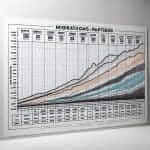Understanding trends in monthly spending on transportation is an essential skill for IELTS candidates, particularly for the Writing Task 1 of the Academic module. This skill helps in analysing and interpreting data presented in various graphical forms. In this article, we will delve into the nuances of this subject, offering a comprehensive breakdown of how to approach such questions effectively.
Understanding the Topic
The topic “Average Monthly Spending on Transportation (2000-2023)” commonly appears in IELTS Writing Task 1 in the form of line graphs, bar charts, or tables. These types of data visualizations require candidates to summarize and explain key features and trends in a clear and coherent manner. Here’s a suggested prompt:
Exam Prompt: The line graph below shows the average monthly spending on transportation in a particular country from 2000 to 2023. Summarise the information by selecting and reporting the main features, and make comparisons where relevant.
Analysing the Data
Before writing, it is essential to analyse the data thoroughly. Let’s hypothetically create a line graph for illustration:
 Average Monthly Transportation Spending (2000-2023)
Average Monthly Transportation Spending (2000-2023)
The above graph can include hypothetical data such as:
- The average monthly transportation spend started at $100 in 2000.
- It increased steadily to $180 by 2010.
- From 2010 till 2020, it fluctuated between $170 and $200.
- After 2020, a sharp increase led it to peak at $280 by 2023.
Writing Sample Task
Introduction
When writing an introduction, you should paraphrase the prompt. An introduction for the task might look like this:
The line graph illustrates the average monthly expenditure on transportation over a period of 23 years from 2000 to 2023 in a particular country.
Overview
Next, write an overview summarising the main trends and any significant points:
Overall, the average monthly spending on transportation has shown a significant upward trend during the given period. The expenditure increased steadily from 2000 to 2010, then experienced fluctuations between 2010 and 2020, followed by a sharp rise after 2020.
Body Paragraphs
Divide the data into two or three body paragraphs. Here’s an example:
From 2000 to 2010, the average monthly expenditure on transportation rose consistently from $100 to $180. This decade-long period of growth indicates a steady increase in the costs associated with transportation.
Between 2010 and 2020, the average monthly spending showed notable fluctuations, ranging from $170 to $200. This depicts a period of instability, possibly due to varying fuel prices or economic factors influencing transportation costs.
Post-2020, there was a significant surge, culminating in the highest expenditure of $280 in 2023. This sharp increase could be attributed to changes in the transportation infrastructure or regulatory policies impacting costs.
Tips for Writing Task 1
Vocabulary and Grammar
Here are some useful vocabulary and grammatical structures used in describing trends:
Vocabulary:
- Fluctuate (v) /ˈflʌktʃueɪt/ – to change frequently from one level to another.
- Upward trend (n) /ˈʌpwərd ˈtrɛnd/ – an increase over time.
- Peak (v, n) /piːk/ – to reach the highest point.
- Surge (v, n) /sɜːrdʒ/ – a sudden large increase.
- Expenditure (n) /ɪkˈspɛndɪtʃər/ – the act of spending money on something.
Grammatical Structures:
- Comparative sentences:
- “The spending was higher in 2023 than in 2000.”
- Complex sentences using clauses:
- “Although there were fluctuations, the overall trend was an increase.”
Common Mistakes to Avoid
- Misinterpreting Data: Ensure you accurately interpret and report the data. Avoid making assumptions not backed by the data.
- Over-Complicating: Aim for clarity. Use simple and precise language.
- Omitting Key Features: Mention significant trends and changes.
Conclusion
Writing about data trends in the IELTS Writing Task 1 requires clear and structured approaches. By practising with various data sets, like the average monthly spending on transportation, and employing specific vocabulary and grammatical structures, you can aim for a high band score. Remember, your task is to summarize and make comparisons where relevant, ensuring coherence and clarity in your writing.


